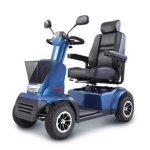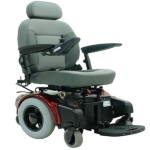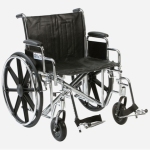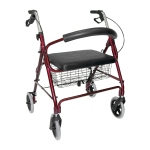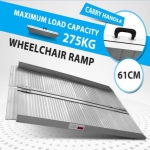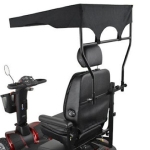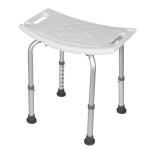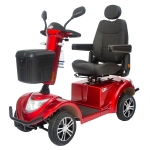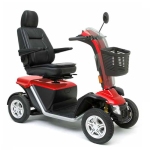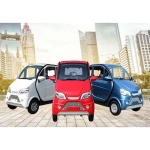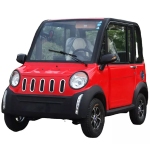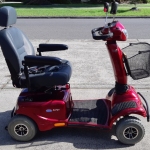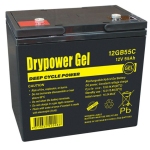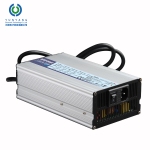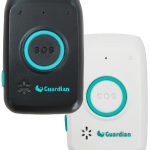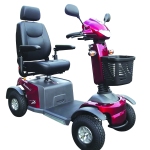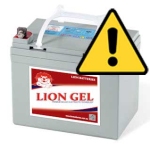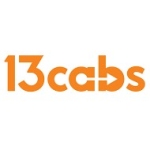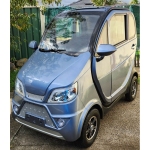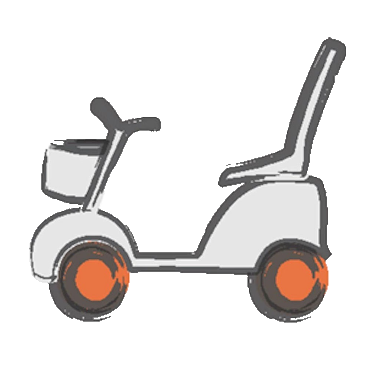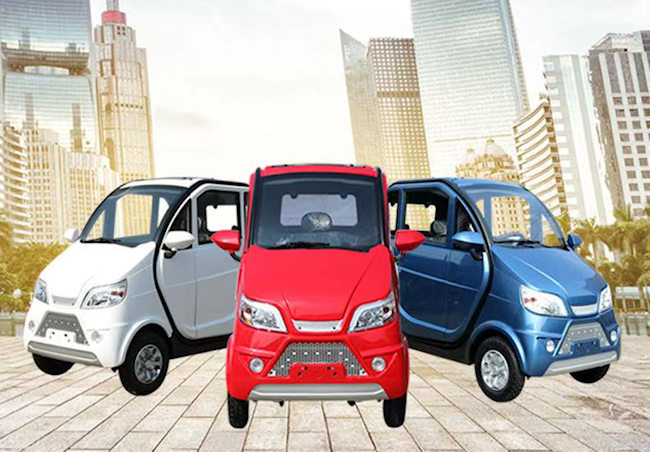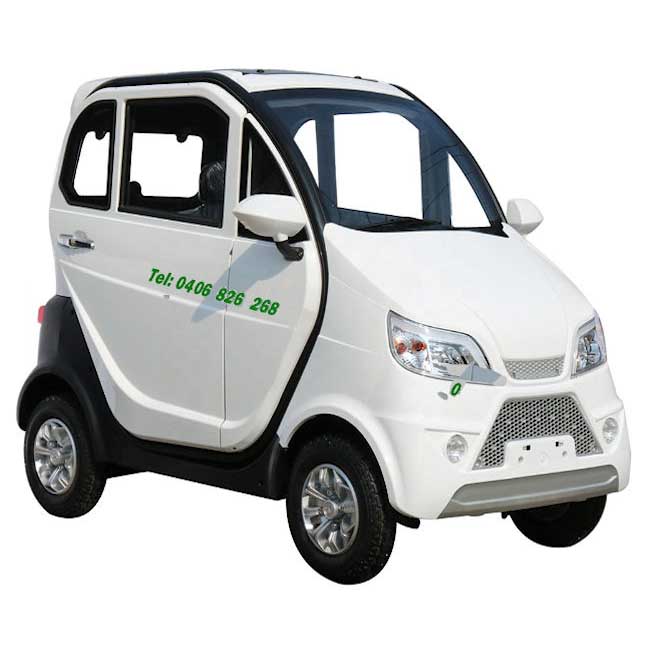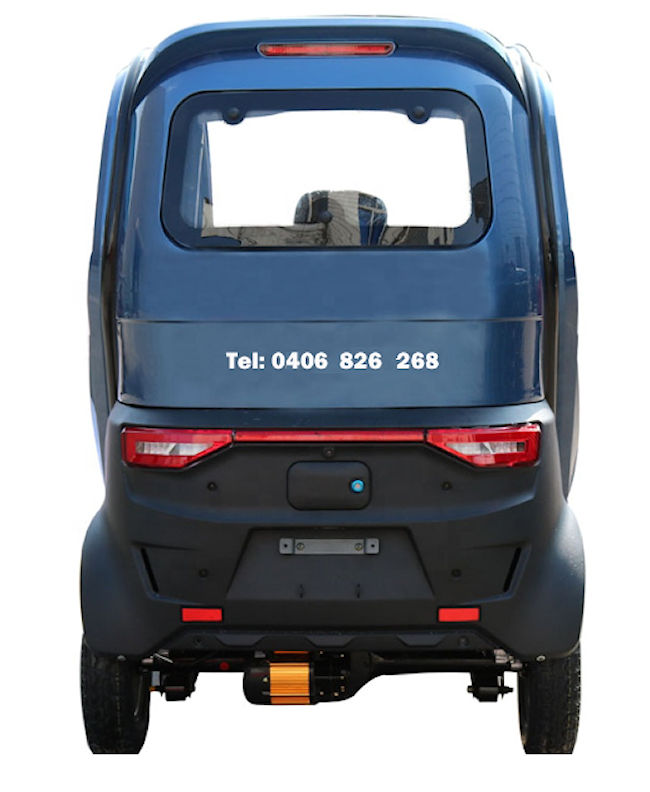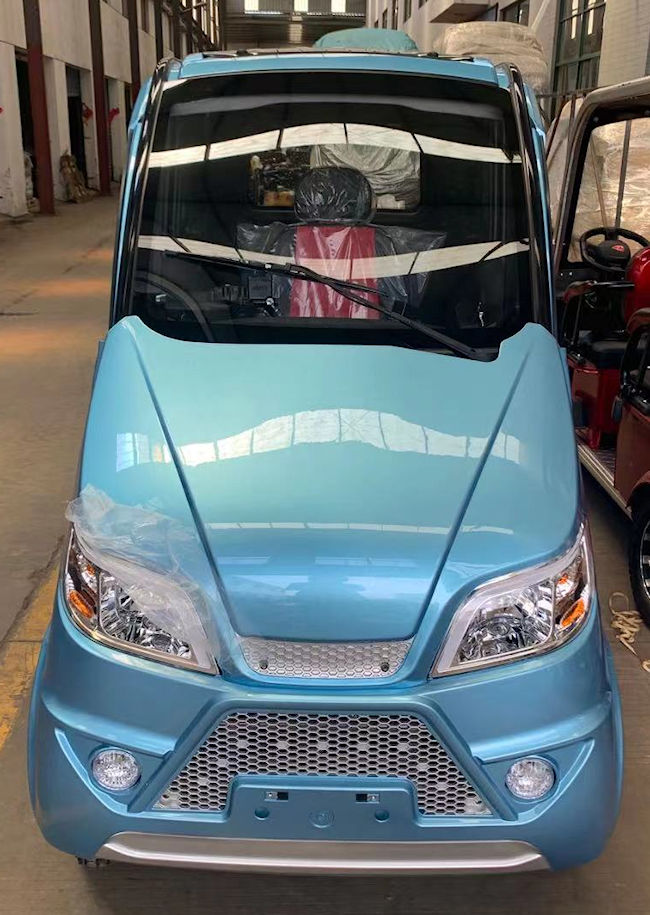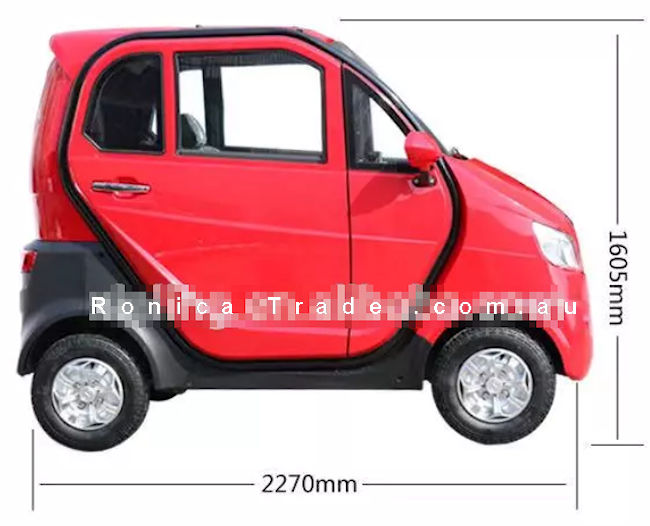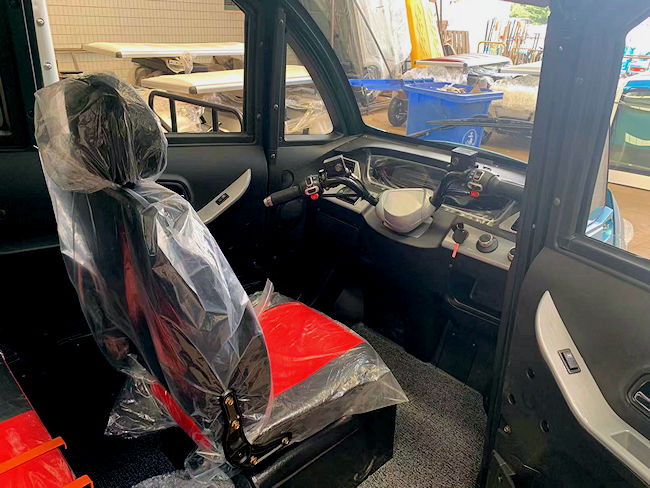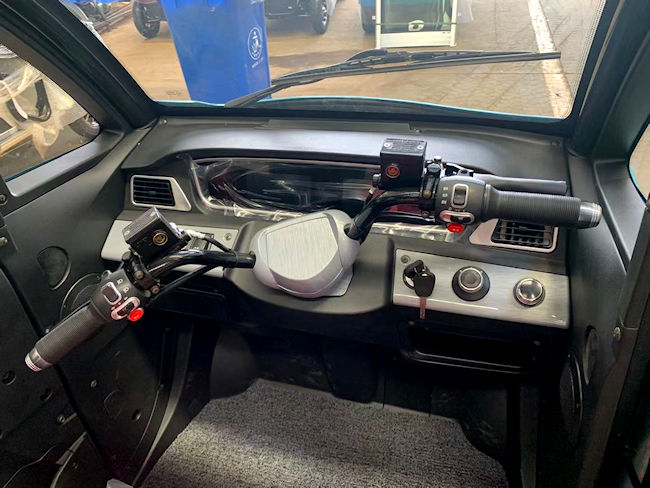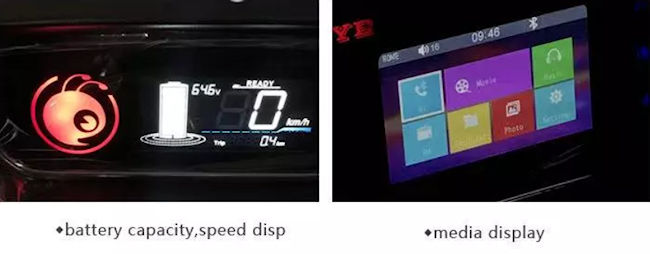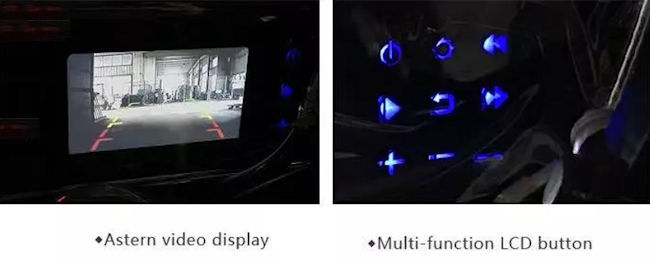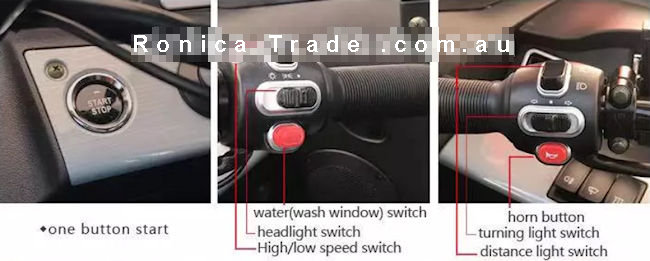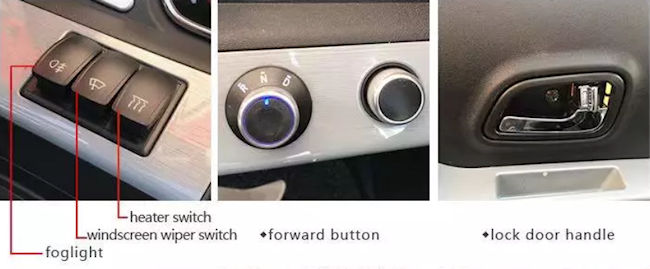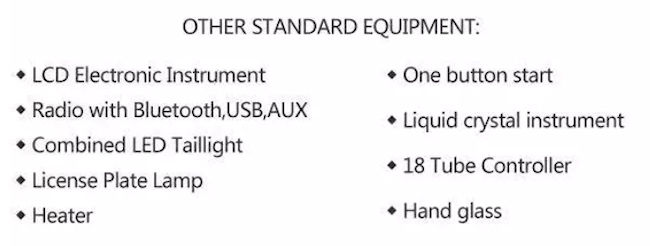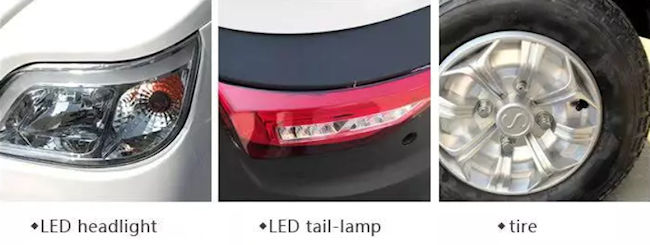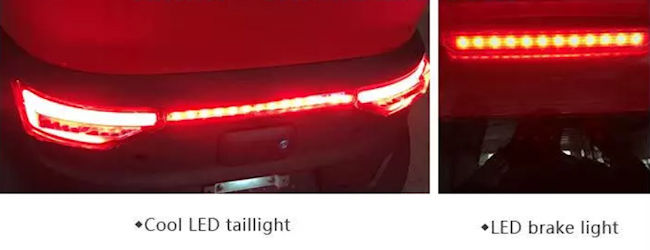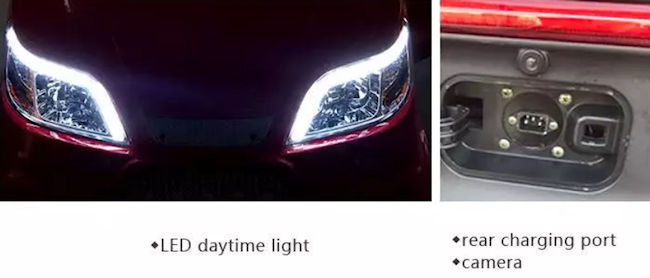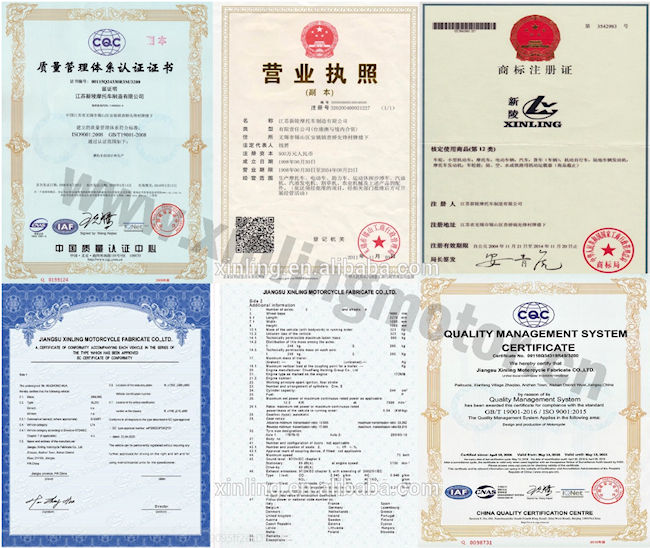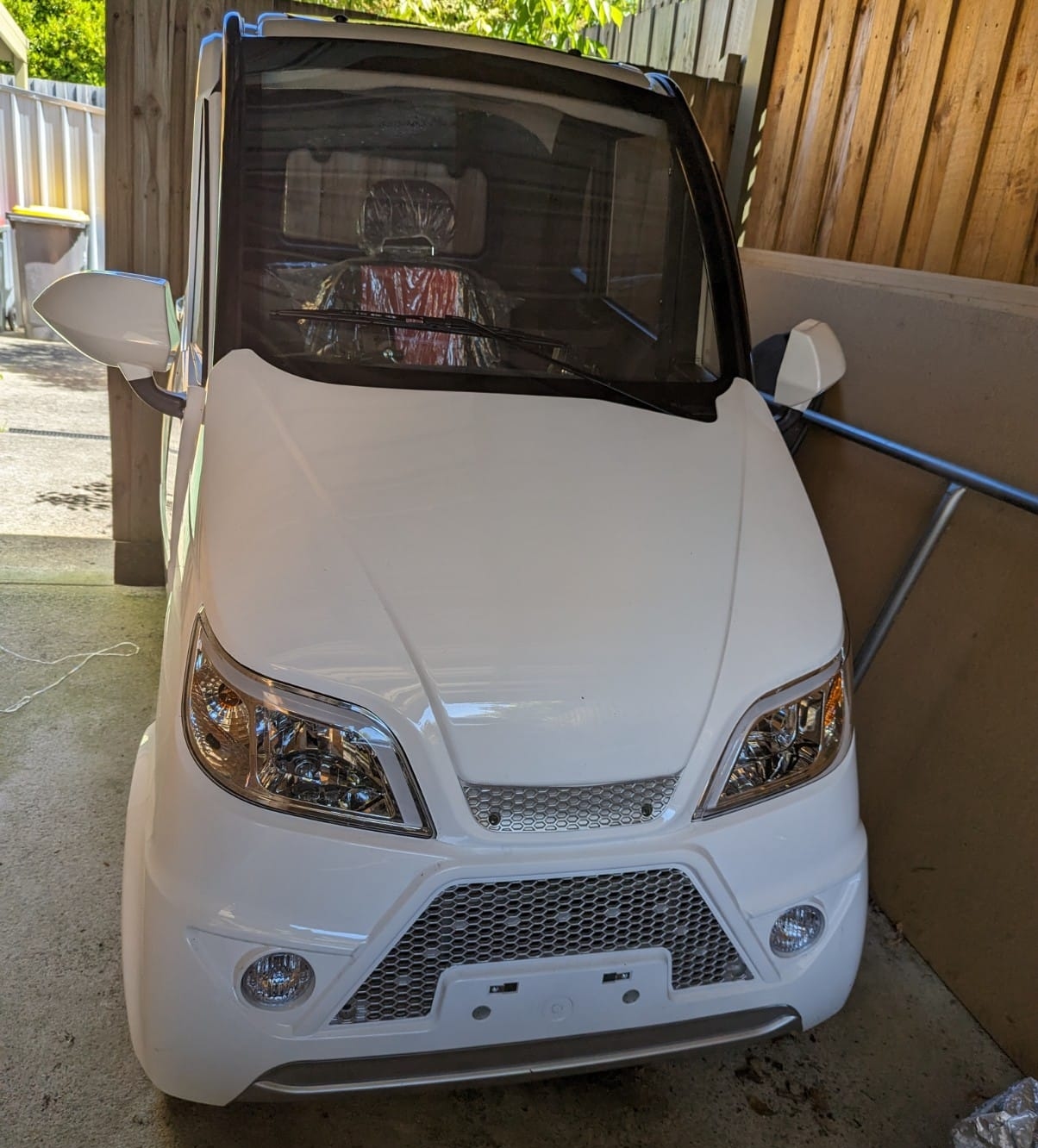Description
DAISY V2 is an advanced, and very comfortable LEMS, luxury enclosed mobility scooter.
DAISY V2 is only a few hands longer and wider than other large cabin mobility scooters, making this luxury enclosed mobility scooter eminently usable and very comfortable even for the largest person, and it is crammed full of refinement, a luxury enclosed cabin mobility scooter at an affordable price.
DAISY V2 has enough power and torque thanks to its’ two-speed differential, to smoothly drive anywhere you want to go, in crowded pedestrian footpath traffic and at a comfortable speed in the open, and has a 60-65 km driving range.
DAISY V2 is an all-weather LEMS, luxury enclosed mobility scooter, fit for a royal.
CCC / ISO Certification
Meets all International Standards and requirements for electric motorised mobility deices.
With Hi / Lo Gear Shift ! Go anywhere thanks to the two-speed differential.
DAISY V2 with aircon, 1.5kW, 60V80Ah LITHIUM NMC, 350 kg load, 3.5/7/10/20/30 /kph, 60-80 km and with softer start.
The pictures above say more than a thousand words.
Luxury Enclosed Cabin Mobility Scooters for royals.
Get on the foot/cycle/road paths and see the city and country.
Just get in and forget the weather !
Features
- Two door
- Handle Bar steering
- Maximum range of up to 85 km *
- Maximum usable range 60-80 km *
- Maximum Six speeds 3.5-30 kph
- Hi/Low Gear Shift ! Climb any driveway or hill
- Softer start controller
- Maintenance Free Deep Cycle Lithium Battery
- Front and rear adjustable damping suspension
- Four wheel disk brakes
- Four wheel parking brakes
- Brushless no maintenance DC motor
- Heavy duty controller
- Weight capacity 350kg
- Driver weight capacity 250 kg
- CCC / ISO Certification
- TGA /ARTG number : 412430
* Depends on user mass, terrain and battery type / size and condition, based on 80 kg driver on straight and level smooth hard ground, all things in good condition, and a steady speed.
Equipment:
- Handlebar steering and controls
- Windscreen wiper with washer
- Key lock door
- Electric windows
- LCD electronic instrument dashboard
- Blue tooth, USB, auxiliary
- MP3 Media and Radio with multi display function control
- Battery capacity gauge
- Speed display large easily seen digital
- Odometer
- Tripmeter
- Speaker
- Rear vision mirrors
- Rear view camera
- Rear plate light
- Key start / stop
- Heater / Demister
- Air Conditioner
- LED lights powerful and elegant
- High / low beam halogen head lights
- Fog light
- Indicators
- Soft start controller
- Three electronic maximum speeds
- Hi / Low differential gear shift
- Horn
- Two doors with locking
- Large skylight opening
- Rear window opening
- Good hydraulic shock absorbing suspension
- Large wheels with pneumatic tyres for a good ride
- Hydraulic disk brakes four wheels
- Park brakes on two / four wheels
- Sliding / tilting front captain’s seat – comfortable
- Seatbelts – front Lap and Diagonal, rear Lap
- Large space in rear can be used for shopping, goods, or even other mobility aids such as a Travelscoot or a walker / rollator
- If you intend to use the rear area for a passenger, please check with your state road regulator authority and obtain permission, if required
Specifications
Manufacturer: Xili Vehicle Co
Exporter: Jiangsu Ruipaiying Import and Export Co Ltd
Importer: Ronica Trade Pty Ltd
Model Number: HMY
Model: Daisy
Model Version: Daisy V2
Certification: CCC / ISO 9001
Registration TGA /ARTG number : 412430
Available Colours: 13 Colour Options
Dimensions: 227 x 110 x 160 cm (L x W x H)
Weight (total): 337 kg
Weight without batteries: 300 kg
Weight capacity: 350 kg
Driver capacity: 250 kg
Wheelbase: 154 cm
Span Rear Wheels: 98 cm
Body Type: Unitary construction
Maximum speed: 3.5 / 7 / 10 / 20 / 30 kph
Do not exceed 10 kph on paths with pedestrians
Maximum range *: 80 km usable
Maximum slope *: 23° 44%
Ground Clearance: 15 cm
Heater: 800W
Aircon: 800W
Motor: 60V 1500W brushless DC
Drive Type: Rear automatic control with two speeds differential
Braking: Hydraulic disk all wheels
Parking Brake: Hydraulic all wheels
Wheels: 400-10
Suspension: Front and Rear: Integral hydraulic damping
Tyres: 17×4″ 400-10 Front: 220kPa, Rear: 250kPa
Battery: 60V 80Ah Lithium Ternary
Battery charger: 60V 10A
Shipping details (Transporter): 350 kg 226x125x170 cm 4.8 cubic meters
* Varies with user weight, terrain type, driving style, battery charge, battery condition, temperature, and tyre / wheel type and condition. Information taken from manufacturers specifications.
Iterations:
Daisy V1 2021
Daisy V2 2022 Replaced lead acid battery with Lithium battery, added air conditioning
Daisy V2 2023 added 2-speed diff
Daisy V2 2023 added Soft Start
Daisy V3 2024 Electronic regenerative braking, electric brake, foot brake, LiFEPO4 battery
Daisy V4 2024 Looped handlebar with finger operated wig-wag throttle, LiNMC battery
Daisy V3 2025 LiNMC battery
Daisy V4 2025 Sharper steering, max speeds 5/10/15 kph, rear hand grabs
DAISY Motor & Battery Combination
DAISY has been upgraded to have a Motor and Lithium Battery combination giving exceptional performance.
DAISY has a 60V DC 1.5 kW Brushless Motor, powerful and efficient.
DAISY has a 60V 80Ah Lithium battery.
DAISY Lithium battery is so much better than the standard Lead Acid Battery, in many ways, not limited to but including performance and overall driving cost.
In practice depending on driving style, terrain, load, speed etc, you will get around 60-65 km distance, the theoretic maximum is 60-80 km distance. With the heater or air conditioner going, you will get less distance. Also, remember Lithium batteries have a short end phase in their power supply, so run out quickly.
When the battery resting Voltage is 60 Volt, the battery is at 20% SOC and must be charged. While driving, this is when the battery voltage displayed drops to about 57.5V.
And if driven fast this is about 60 km max distance.
These batteries are rated at 500-800 charging cycles.
So, say 60 km x 500 cycles = 30,000 km.
The cost to run DAISY is about 2 cent/km for electricity, and about 12 cents/km for the battery.
Please note, this information is as per this particular type of Lithium battery and is not what you may know or be told about other types of Lithium batteries.
FAQ's
Does a Mobility Scooter / Daisy LEMS need to be registered?
In Australia you do not register your Mobility Scooter, except for Queensland, and it is registered for ownership only.
Do I need a driver’s license to drive my Daisy LEMS Mobility Scooter?
You do not need a driver’s license to drive your Mobility Scooter.
Can I drive my Mobility Scooter / Daisy LEMS on the road?
You may drive your Mobility Scooter / Daisy on a public road if for any reason the footpath is not suitable. You must obey all the rules of a pedestrian or cyclist.
Can I carry a passenger in my Daisy Mobility Scooter?
Your Daisy Mobility Scooter is able to accommodate a passenger or two smaller passengers. It is recommended to notify and obtain approval from your local authority.
What materials is the Daisy Mobility Scooter made from?
The Daisy Mobility Scooter panels are made from ABS, an impact-resistance engineering thermoplastic. The windscreen and windows are made from Tempered Safety Glass, so they will not shatter into shards that cut you if broken. The frame construction is unitary, very strong one-piece steel. All to vehicle industry standards.
How often should I charge my Mobility Scooter / Daisy LEMS?
It is best to charge when the battery is down to no less than 20% charge (SOC). This is after around 60-80 km driving, depending on several driving factors. Zero the odometer after each charge.
When the battery resting Voltage drops to 60V it must be charged.
When charged, disconnect the charger and use your Daisy as soon as possible, the next day is ok, to use some of the top charge in the battery, as the special Lithium battery prefers not to be left fully charged.
When in storage, the Lithium battery should be at approximately 63-65 V, half full, or half empty, and make sure the LEMS’s Power / Overload switch is OFF, so there is no chance of accidentally drawing current from the stored battery.
Check the battery voltage every month and top up to 63V if required.
If the battery goes below 49 volts, the BMS (battery management system) will switch off to protect the battery, and the battery will have to be returned to Ronica Trade to try and remedy the situation. There is a 250.00 fee (if successful) to attempt the resurrection, and no guarantees.
How can I check I am charging my Daisy Mobility Scooter at the right time?
The recommended way of checking the power used and replaced by the charger is to purchase a 240V Plug Power Meter and check your power usage. The 80Ah battery has 4.8kWhr (4800 Whr) of power in it when full, and at 20% SOC it will require 3.84 kWhr to fill to 100% SOC. The results will give you an idea of what power you are using and what kms you can travel without going below the 20% SOC.
What is the average life of a Mobility Scooter / Daisy battery?
The Daisy lithium batteries last around 500+ full cycles. To ensure the battery lasts as long as possible, follow the charging instructions as in the previous question. Check the Daisy Motor / Battery Combination section for further details.
Why is a Lithium battery so much better than a Lead-Acid battery?
Firstly, the voltage platform is higher for a Lithium battery, and thus there is more power produced by the motor, and more consistently.
Secondly, the power available (power density) is much greater, making the battery much lighter, and thirdly the power is able to be delivered faster.
Lastly, the ideal temperature for all batteries is 25 C. Temperature limits are, for Lead Acid 0-+35 C, for the Daisy Lithium battery it is -20-+45 C. Temperatures over 35 C damage lead acid batteries.
Is the Saisy Mobility Scooter battery safe ?
Everyone by now has heard of Lithium battery fires occurring. All of the fires can be accounted for due to many individual factors that are not the norm in the use of the original lithium battery with the correct charger.
The Daisy‘s Li Ternary battery is safe if use as instructed, and they are of similar chemistry to the Tesla battery.
What is the running cost of a Daisy?
The electric power cost for the Daisy is approximately 2 cents/km.
As in all electric mobility devices, it is the cost of the battery that is the expensive part.
The total running cost of a Mobility Car is about 12 cent/km plus any servicing.
Can I use other batteries in my Daisy?
You could use another type of battery in the Daisy, but the type installed from new is by far the best for the job, as explained in the answers above.
We recommend to only install the correct battery available from your dealer or directly from Mobility Scooters for Hire Sale Service.
What is the service schedule for Daisy?
Daisy requires a service every year or 1000km. Change the differential oil with SAE 80W-90 gear oil. Use 3in1 oil on all joints and moving parts. Wash with running water and a very soft cloth or brush, and wipe as required with a damp soft cloth. Do not use detergents or other cleaners, they are not required. Never wipe in a dry condition, as the dust and sand will scratch surfaces. A UV Protectorant polish is recommended to be applied monthly after washing to protect the paint covering from Australia’s harsh sun’s UV damage.
What is the correct way to connect the power to the charger?
Operation Instructions :
Connect outlet plug of the charger to the Daisy.
Connect the inlet plug of the charger to AC power socket, and when or if connected, turn the power switch on.
When the indicator light is RED it is charging (sometimes this maybe flashing at around one second intervals). When GREEN it is fully charged.
Charging time is proportional to the power required to fully charge the battery, and that is what was used since the last charging.
To disconnect the charger, turn off or remove the charger input plug from the AC power supply.
Remove the charger outlet plug from the Daisy.
Notes :
Do not use outside in the sun, rain or damp
Do not use in dusty conditions
Do not place on inflammable materials
Do not drop
Ensure the correct charger is used for correct battery type and capacity.
Some chargers have different colour light sequences, please check and note when first using.

